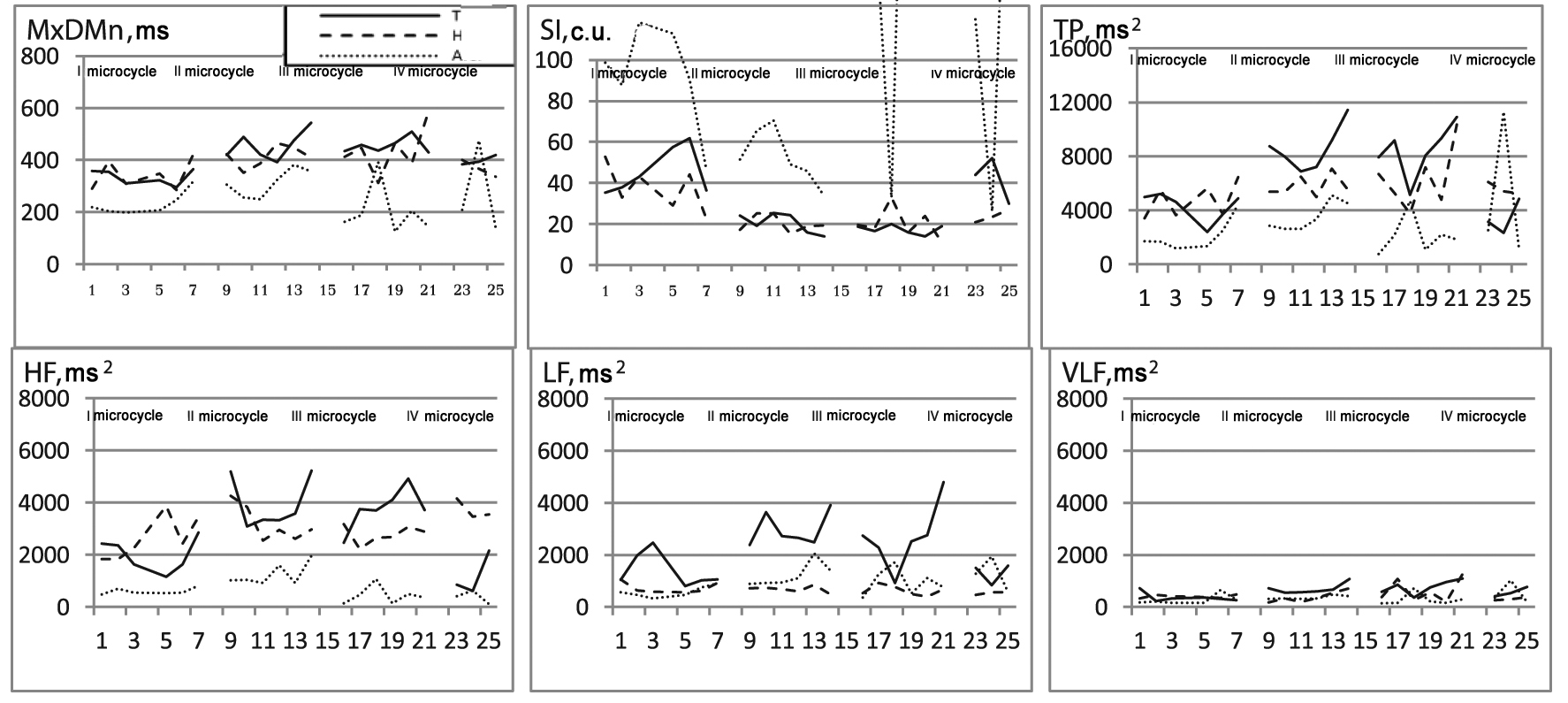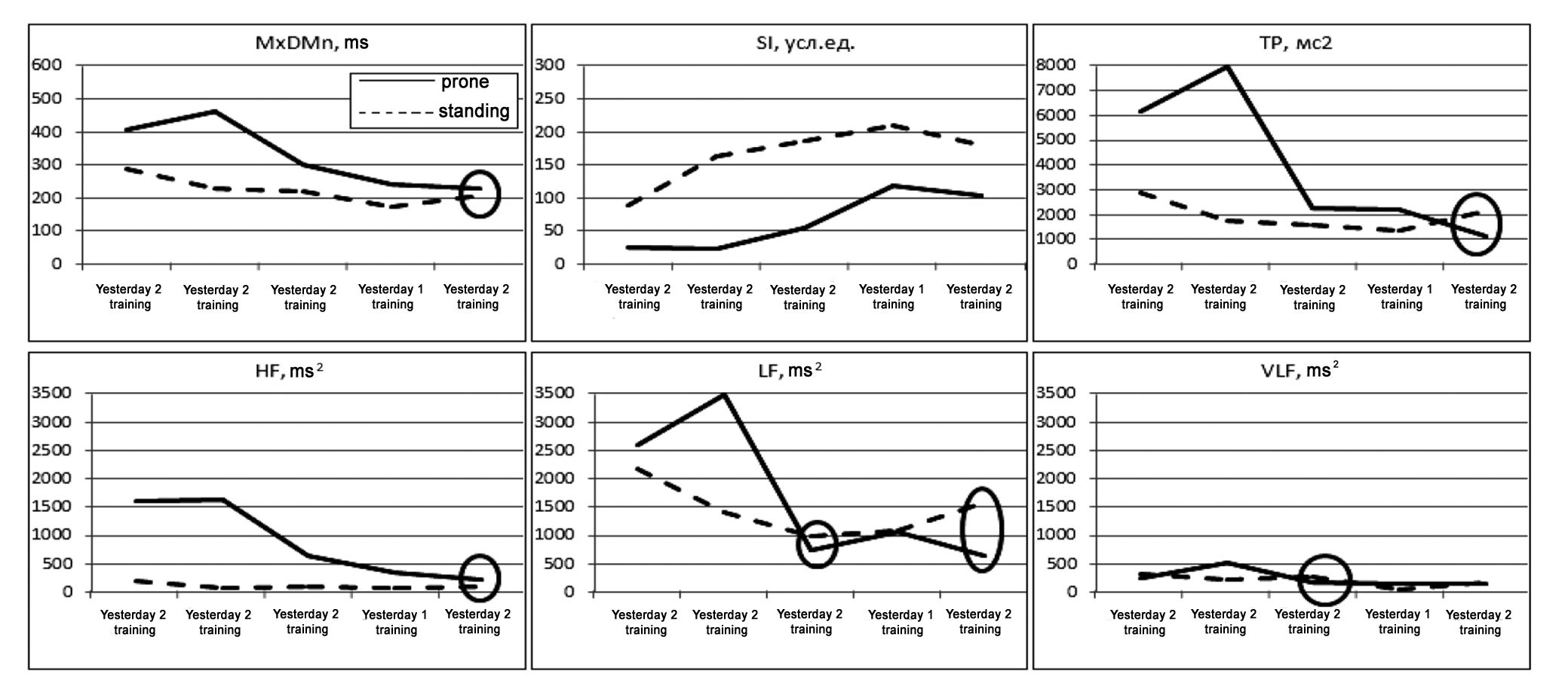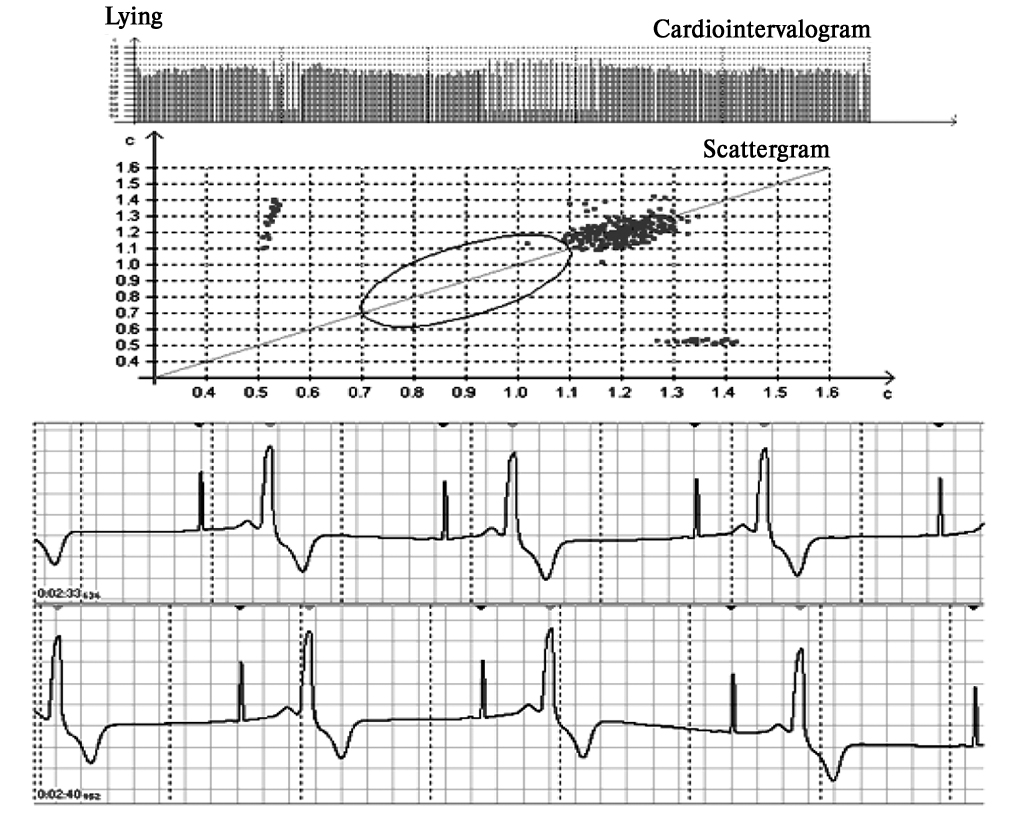Individual approach to training process analysis based on heart rate variability data of track athletes in middle altitude conditions
Фотографии:
ˑ:
Dr.Biol., Professor N.I. Shlyk1
Associate Professor, PhD A.E. Alabuzhev1
Associate Professor, PhD I.I. Shumikhina1
1Udmurt State University, Izhevsk
Introduction. Climatic conditions influence on the functional state of athletes is a pressing issue in sports. Data on the benefits of the training process in the mountains found in the literature on the subject are quite contradictory [1, 3]. Trainers often use exercise modes similar to those used in the plains in the new environmental conditions [1, 3, 4]. Such an approach to the training process leads to a disruption of adaptation and reserve systems and a decrease in efficiency that later take long to restore.
Autonomic dysfunction in sports is one of the most common disorders [3, 6]. The work of any coach requires constant dynamic monitoring of the functional state and reactivity of athletes’ regulatory systems determining the efficiency of the adaptive mechanisms and their possible failures [2, 4]. This control is especially important while training under changed environmental conditions – under a lower atmospheric pressure. Trainers tend to forget that it takes each athlete different time to acclimatize. The risk of overtraining increases when the amount and intensity of physical loads rise against the background of acute acclimatization to new environmental conditions. To avoid it, it is necessary to use the integral method of functional state as well as regulatory and adaptive capabilities assessment on a daily basis. Express test of heart rate variability (HRV) based on individual typological characteristics of autonomic regulation is such a method [9, 12]. Unfortunately, there are little data on dynamic studies of HRV of track athletes in middle altitude conditions [3, 5, 6].
The objective of the study was to identify individual differences in the adaptation and reserve capabilities of track athletes with various specific focuses of the training process based on dynamic HRV observations at the training camp in the middle altitude conditions.
Research method and organization. The observation involved 8 elite (Candidate Masters of Sports and Masters of Sports) track athletes with various purposes of the training process (sprinters, long-distance runners, marathon runners) at training camps in the middle altitude conditions (Kyrgyzstan, Kislovodsk, 2014-2016). An express HRV test based on the predominant type of autonomic regulation and reactivity in the supine (5 minutes) and standing (6 minutes) positions was performed prior to the first training of the day for 24 days of each training camp. Recording and analysis of the cardiorhythmograms were conducted by means of Varicard 2.51 complex and Iskim-6 software. Methodology of HRV studies while at rest and in orthostasis based on the predominant type of autonomic regulation had been described in a number of our previous works [4, 5, 7]. The nature of exercises performed by each athlete the day before was taken into account while analyzing HRV parameters.
Results and discussion. Figure 1 presents individual “images” of HRV values while at rest in three athletes – one sprinter and two long-distance runners – during four microcycles at a training camp in the middle altitude conditions (Kyrgyzstan). According to HRV analysis, central regulatory contour is moderately prevalent in sprinter A during the training camp. This type of regulation is characterized by low values of such HRV parameters as MxDMn, TP, HF, LF and VLF and high SI compared with long-distance runners T and N. Strain of the central regulatory contour in sprinters is associated with a big volume and intensity of specific anaerobic loads. In case of long-distance runners, on the contrary, the training process has more to do with aerobic training loads. Autonomous regulatory contour moderately prevails in long-distance runners, so such HRV values as MxDMn, TP, HF, LF and VLF are higher, and SI is lower than those of sprinters. HRV analysis results confirm that the state of regulatory systems differs depending on the training process orientation [2, 4].

Figure 1. Autonomic regulation differences observed during dynamic HRV studies in middle altitude (Kyrgyzstan) in sprinter A and long-distance runners T and N.
Note. Long-distance runners perform the same training loads throughout the training camp.
In the same figure one can trace in terms of HRV individual differences in the functional fitness of long-distance runners T. and N. experiencing the same training loads throughout the training camp. Long-distance runner T. has more pronounced values of such HRV parameters as MxDMn, TP, HF, LF and VLF and a lower value of SI, which indicates a good functional fitness level of the athletes to cope with increasing training loads. At the same time long-distance runner N. copes with the same loads with more autonomic regulation strain, so it is necessary to reduce the volume and intensity of his training loads.
By HRV parameters dynamics in Figure 1 one can observe correct load planning and specific characteristics of adjusting to these loads in each of the four microcycles. The figure shows that athletes have lower values of such HRV parameters as MxDMn, TP, HF, LF and VLF and higher SI in the first and fourth training microcycles than in the second and third ones, indicating strain of the cardioregulatory systems.
If the autonomic regulation strain in the first microcycle is due to the fact that the athletes started training immediately, against the background of acute acclimatization, in the fourth microcycle the increase in the regulation systems’ strain is associated with excessive training loads at the end of the training camp and fatigue developed. Consequently, it takes more energy and efforts of the athletes to perform the training loads in the first and fourth microcycles.
The issue of the timing for inclusion of a rest day in a microcycle when training twice a day at middle altitudes requires special attention.
Figure 2 presents results of HRV analysis while at rest and in orthostasis for a sprinter training twice a day at a training camp in Kislovodsk for 5 days. Based on insufficient, excessive or paradoxical autonomic reactivity one can determine more accurately the state of the adaptive and reserve capabilities of the body and the appearance of early signs of overtraining. It was found based on the HRV analysis results in orthostasis that functional, regulatory and reserve capabilities of a sprinter are sharply reduced after the third training day which is reflected in a decrease of such HRV parameters as MxDMn, TP, HF, LF and VLF at rest, a reduction in autonomic reactivity to orthostasis and an emergence of a paradoxical reaction at the end of a microcycle indicating dysregulation and an increased cardio load.

Figure 2. Autonomic reactivity change in a sprinter having two training sessions per day in a microcycle at a training camp in Kislovodsk.
According to our longstanding practice, heart rate studies do not always reflect the true state of the heart rate regulation mechanisms. One and the same heart rate can correspond to different cardioregulatory systems involved. Therefore, in the athletic training process it is important to consider not the heart rate, but its value according to HRV analysis. The most lucid example of HRV analysis results is that of B, a marathon runner, whose HR at rest is 59 beats/minute (see the table in Figure 3). According to the table very high values of such HRV parameters as MxDMn, TP, HF, LF, VLF, ULF and a low value of SI at rest and during an excessive response to orthostasis were observed in the athlete along with moderate bradycardia. At the same time cardiac rhythm disturbances can be noted on the cardiointervalogramm, HRV scattergram and ECG at rest (see Figure 3). The idea is that, in addition to the quantitative assessment of HR and HRV parameters, it is important to consider cardiointervalogram, scattergram and ECG too when analyzing HRV. Only in this case one can avoid misinterpretation of the state of the cardioregulatory systems. This athlete should not attend training camps at middle altitudes. It is necessary for him to consult a cardiologist. Before the first HRV cardiointervalogram was recorded the athlete had run three marathons in the mountains uncontrolled.
Table 1. Results of HRV analysis of a resting marathon runner, B, at a training camp in Kyrgyzstan.
|
HR, bpm |
MxDMn, ms |
SI, c.u. |
TP, ms2 |
HF, ms2 |
LF, ms2 |
VLF, ms2 |
ULF, ms2 |
||||||||
|
prone |
standing |
prone |
standing |
prone |
standing |
prone |
standing |
prone |
standing |
prone |
standing |
prone |
standing |
prone |
standing |
|
59 |
85 |
928 |
142 |
7 |
421 |
19830 |
389 |
8583 |
61 |
1433 |
155 |
4673 |
76 |
5141 |
96 |
* HRV parameters in bold indicate a deviation from the norm.

Figure 3. Results of analysis of cardiointervalogram, scattergram and ECG of a resting overtrained marathon runner (B) at a training camp in Kyrgyzstan.
Conclusion. Results of dynamic studies of HRV in track athletes while at rest and in orthostasis at training camps in the middle altitude conditions provide important information about the state of autonomic regulation and tolerability of training loads of various orientations. Disruption of the autonomic balance and reactivity in case of two training sessions daily at middle altitudes is an important signal for the timely adjustment of the training mode in each microcycle.
Balanced autonomic regulation that takes into account the specific focus of the training loads of track athletes maximizes functionality during training sessions at middle altitudes. The absence or neglect of clear understanding of the individual limits of the regulatory and reserve capabilities of the body by the trainer, planning the same training loads and tolerability control based on HR can cause only overtraining and be accompanied by poor sports performance.
References
- Aghajanyan N.A., Baevskiy R.M., Berseneva A.P. Uchenie o zdorove i problemy adaptatsii [Teaching on health and adaptation problems]. Stavropol: SSU publ., 2000, 204 p.
- Gavrilova E.A. Sport, stress, variabelnost [Sport, stress, variability]. Moscow: Sport publ., 2015, 168 p.: il.
- Cherkes L.I., Ilyin V.N. Faktory, opredelyayushchie funktsionalnoe sostoyanie regulyatornykh sistem organizma u sportsmenov posle prebyvaniya v usloviyakh srednegorya [Factors determining functional state of athletes' regulatory systems after stay in middle altitude conditions]. Fiziol. zhurn., 2012, vol. 58, no. 4, pp. 30-34.
- Shlyk N.I. Serdechny ritm i tip regulyatsii u detey, podrostkov i sportsmenov [Heart rate and regulation type in children, adolescents and athletes]. Izhevsk: Udmurt University publ., 2009. – 259 p.
- Shlyk N.I., Alabuzhev A.E., Feofilaktov N.Z., Sleptsov A.O. Dinamicheskie issledovaniya variabelnosti serdechnogo ritma u legkoatletov-srednevikov v trenirovochnom protsesse v usloviyakh srednegorya [Dynamic studies of heart rate variability in middle-distance athletes during training in middle altitude conditions]. Mat. V Vseros. simpoziuma s mezhdunar. uchastiem "Variabelnost serdechnogo ritma: teor. aspekty i prakt. primenenie" [Proc. V All-Russia Symposium with Intern. participation "Heart rate variability: theor. aspects and practical application"]. Izhevsk, 2011, pp. 369–384.
- Shlyk N.I., Alabuzhev A.E., Alabuzhev S.A. et al. Individualny podkhod k analizu variabelnosti serdechnogo ritma u legkoatletov na sborakh v usloviyakh srednegorya [Individual approach to study of heart rate variability in athletes in training camps in middle altitude conditions]. Mat. VI Vserossiyskogo simpoziuma s mezhd. uchastiem "Ritm serdtsa i tip vegetativnoy regulyatsii v otsenke urovnya zdorovya naseleniya i funktsionalnoy podgotovlennosti sportsmenov" [Proc. VI All-Rus. symposium with international participation "Heart and type of vegetative regulation in people's health and athletes' functional fitness rating"]. Izhevsk, 2016, pp. 300–306.
- Shlyk N.I. Ekspress-otsenka funktsionalnoy gotovnosti organizma sportsmenov k trenirovochnoy i sorevnovatelnoy deyatelnosti (po dannym analiza variabelnosti serdechnogo ritma) [Express evaluation of athletes' functional fitness for training and competitive activity (based on heart rate variability study data)]. Nauka i sport: sovremennye tendentsii, 2015, no. 4 (Vol. 9), pp. 5-15.
Corresponding author: medbio@uni.udm.ru




